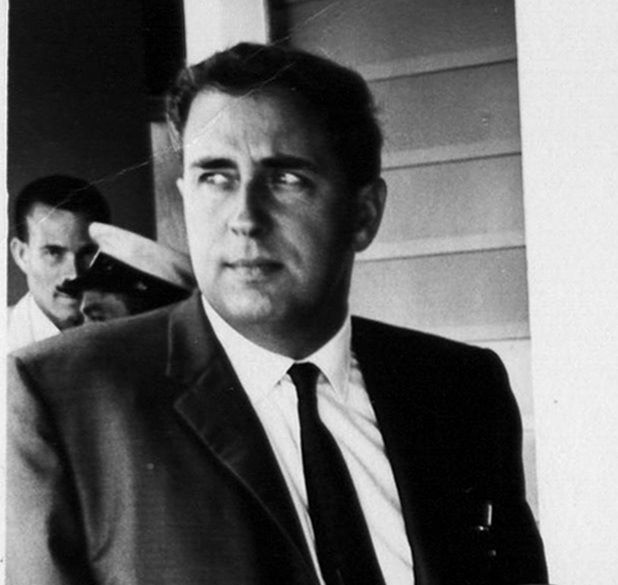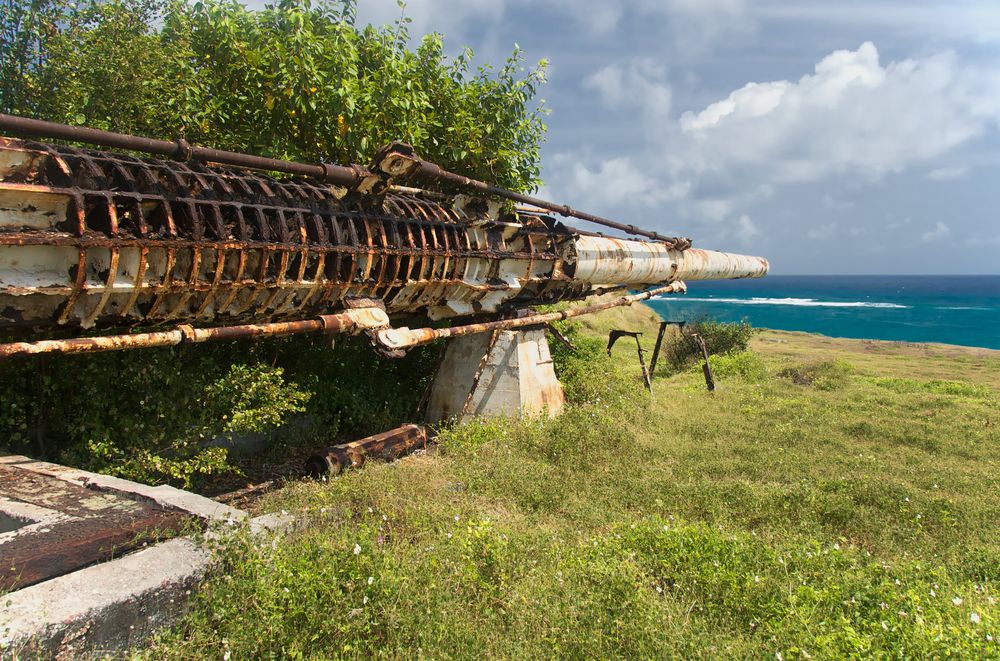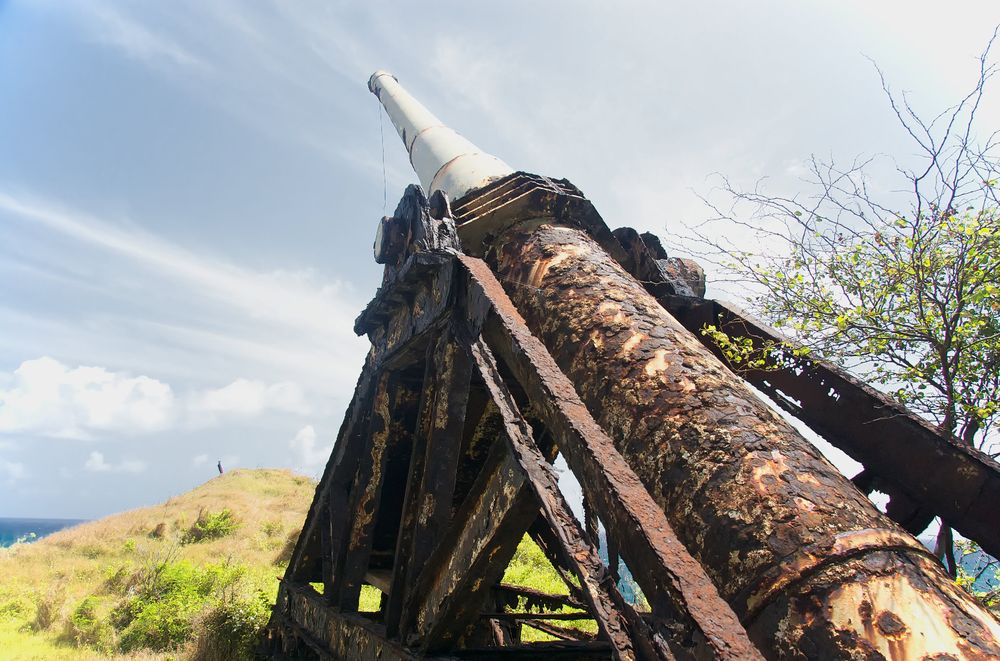When Jules Verne sent three men to the moon in his 1865 novel From the Earth to the Moon, he did so in a projectile fired from a massive gun. Even Verne, known for his visionary and a futuristic ideas, did not believe a rocket could do the job. Rockets of the era were relatively small and crude gunpowder-based devices used only for firing projectiles into enemy land. But as rockets grew in power and sophistication, it became the primary and currently the only method of launching things into space. But gun propulsion as a method of space launching was not entirely abandoned.

The 16-inch gun used during Project HARP, along with a smaller gun in Barbados. Photo: Graham/Flickr
In the late 1950s, Canadian engineer Gerald Bull became convinced that a space gun would be more economical to launch satellites into orbit. Bull argued that a space gun would not need expensive rocket motors, and unlike rockets, the gun could be reused. Bull conducted some preliminary launch experiments using small guns at the Defence Research and Development Canada, Valcartier (CARDE). These experiments soon caught the attention of the US Army, who were carrying experiments with rockets to collect air from the upper atmosphere in order to design better jet planes. The US Army needed a method that was economical, and Bull’s ballistic approach sounded promising.
In 1961, Bull resigned from CARDE and successfully pleaded the US Army for funding, and project HARP (High Altitude Research Project) was officially born as a program under McGill University's Space Research Institute. HARP was presented as a research initiative dedicated to “developing low-orbital capacity for geodetic and atmospheric objectives”. But its ultimate goal was to place satellites into orbit.

Gerald Bull.
A research station was established in Barbados, then still a British colony and part of the West Indies Federation. Barbados was chosen for two reasons—first, the site was close to the equator, which allowed the launcher to take advantage of the extra velocity imparted to the projectile by the earth’s rotation, and second, the site provided an expansive downrange area over the Atlantic ocean for safe impact of re-entry projectiles. The Barbados government welcomed the project hoping that it would give the impoverished island nation an impetus into space exploration research.
The US Army supplied Bull with two 16-inch naval gun barrels—the largest artillery piece in the American arsenal, each weighing 140 tons—complete with a land mount and surplus powder charges, a heavy-duty crane, and a $750,000 radar tracking system. The guns were welded together to produce a single barrel, 119 feet (36 m) long. It was then installed at the newly established High Altitude Research Facility, by digging a gun pit into the island’s coral base, and a concrete emplacement was built on a plateau so that the gun barrel could stand vertically.
The first test shot from the 16-inch gun was fired on January 20, 1963. A 315 kg test slug reached an altitude of 3,000 meters in 58 seconds before coming down a kilometer off-shore. After the successful firing, the HARP program switched to dart-like finned projectile named Martlet, named after the mythical bird that appeared on the McGill University crest. Inside the gun barrel, the Martlet was surrounded by a wooden casing called sabot that protected the projectile as it traveled through the barrel by absorbing the combustive energy, and then splitting apart in the air after the Martlet exited the barrel.

Firing of a Project HARP gun in Barbados.
The Martlets kept evolving throughout the test period, growing in size and sophistication and reaching greater altitudes. The first Martlet, launched in early January 1962, reached 26 km, but by November 1962, Martlets were reaching altitudes of 66 km. The Martlet 2 missiles, which began testing in April 1963, reached a record 92 km. By the end of 1965, Project HARP fired more than one hundred missiles at heights over 80 km into the ionosphere.
The Martlets carried a variety of instruments to measure the atmosphere. Some released chemicals such as triethylaluminium, which reacted with air to produce smoke, that was used to measure winds by visual means. Others released chaff instead of chemicals, allowing tracking via radar. Some shots used additional electronics to measure the magnetic field. Over half of all data that we have on the upper-atmosphere to this day had been collected during the HARP mission.
The increasingly rich information that the project kept feeding the US Army convinced the federal government agency to increase funding six fold, from $250,000 a per year to $1.5 million. The Canadian Department of Defence Production also agreed to chip in with an additional $1.5 million per year. Part of the reason of the HARP gun’s success was its low cost. The firing of the Martlet 2 cost from $2500 to $3000 and took only half an hour to load.

Photo: Graham/Flickr
For Gerald Bull, Martlet 2 was only a stepping-stone on the way to his real interest—a gun-launched rocket that could reach outer space, and this led to the next phase of the project, Martlet 3. The goal of Martlet 3 was to test the basic problems of launching a solid-fuel artillery shell from guns, and find out how the fuel behaved under high acceleration. The idea was to launch a fuel-filled projectile from a gun, which would ignite mid-flight to send the missile into orbit. Martlet 3 would try out the concept with a smaller bore of 7 inch, but Martlet 4 was to be of 16 inches and consist of 3 stages of solid rocket motor. Unfortunately, the project ran out of funding and no Martlet 4 vehicles were built. However, Project HARP did set the world altitude record for any fired projectile on November 18, 1966, when a 16-inch gun at Yuma Proving Ground launched an 84-kg Martlet 2 missile to 180 km. The record still stands today.
In the late 1980s, the US government started a new project called Super High Altitude Research Project (SHARP) to continue research into the firing of high-velocity projectiles into the upper atmosphere. This time, instead of using regular explosives as the propellent, SHARP built a gun that used compressed hydrogen to accelerate the projectiles. During test firings, the SHARP gun achieved velocities of 3 km/s. Had the project continued, there were plans to elevate the tube and begin space launch trials potentially reaching speeds of up to 7 km/s. The eventual goal was to build a mammoth gun with a barrel 3.5 km in length for launching satellites.
After the failure of Project HARP, Gerald Bull started a new company called the Space Research Corporation and established himself as an international artillery consultant. In 1988, he was hired by President Saddam Hussain to build a massive cannon for Iraq with a range of up to 1,000 km, making Israel and central Iran well within reach of Iraqi artillery fire. Two years later, while returning to his apartment in Brussels, Bull was shot five times in the head by Israeli Mossad agents, halting Project Babylon.
Today, you can still see the massive 16 inch cannon at the Barbados test site, lying abandoned and rusting.

This is the smaller of the two main guns. Some of the train track is still in place. Photo: Graham/Flickr

This is the smaller of the two main guns. Some of the train track is still in place. Photo: Graham/Flickr












Comments
Post a Comment